LOVING LEGEND -- LIVING LEGACIES
October 20, 1940. It was on this day, seventy years ago, that Bhagavan Baba unveiled the mystery surrounding His birth, life and mission. He declared to the people around, and through them to the entire mankind, that He indeed is the Supreme Consciousness embodied in a diminutive and delightful form. “I am no longer your Sathya, I am Sai…I have My work; My devotees are calling Me…” He announced candidly on that day.
Ever since, this eternal reservoir of energy and empathy, hope and happiness, solace and succor, light and love, has nursed and nurtured, and ensured that the tiny seed of goodness latent within every individual grows into a gigantic tree of love and serenity. And like a perfect teacher, He has demonstrated this more by living that principle in every moment of His own life. The result is a luminescent legacy that will continue to illumine the dark alleys of humanity’s collective consciousness, elevating it to a state of absolute sublimity for generations to come.
“Loving Legend – Living Legacies” seeks to capture a few salient highlights of this glorious saga of Pure Love. This 30-episode radio documentary starts on October 20, 2010 on Radio Sai to continue daily till November 19, 2010.
Below is the textual adaptation of this audio series embellished with pictures, audio and video clips!
Let us immerse ourselves in the story of His glory and more important strive to make our little lives shine with the sacred glow of purity, nobility and genuine compassion.
Episode 19: The Unfolding of the First Sai School
 |
|
In examining the microcosm of Sai Baba’s schools, we are assured that the macrocosm of His numerous institutions of learning - now and in the future - produces results of the same magnitude.
It was the month of March – the busiest and most crucial period in the life of every 12th Grade student. It would be their second and final rendezvous with a public exam – a test that could make or mar their future. In India, for all schools affiliated with the Central Board of Secondary Education (CBSE), this nation-wide annual assessment conducted by the Board for the students of tenth and twelfth grades is like the Holy Grail.
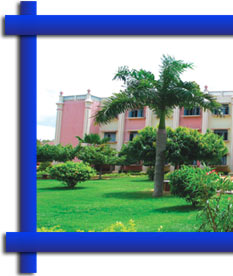 |
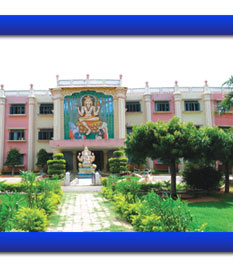 |
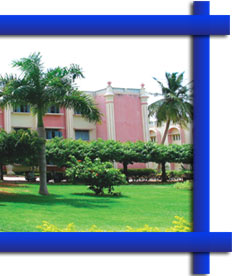 |
Education in Moral Values
During the peak of this busy and stressful period, the scene inside the Sathya Sai Hostel for Junior Boys was understandably hectic. In one corner of the hostel, Satish was preparing intensely for his toughest paper, just a couple of days away. Suddenly, he noticed his classmate Ramesh lying on the bed covered from head to toe. It occurred to Satish that his normally not-so-quiet roommate had been silent for the last hour. So he went near Ramesh and gently touched his hand. His heart sank.
 |
His fellow student and dormitory mate was sick. Extremely weak and running a temperature, Ramesh was in no position to prepare for the exams. Satish himself could not concentrate on his studies any further with his classmate in such a helpless state. So, he brought Ramesh’s condition to the notice of those concerned. Despite being administered with medication, Ramesh’s energy levels continued to be low. His predicament weighed heavily on Satish’s mind.
Unmindful of the fact that he had not completed his own study for the tough exam ahead, Satish sat by Ramesh’s bedside and read out all the chapters, questions and answers, explaining every detail slowly and clearly until he was convinced the content was well registered in Ramesh’s mind.
It didn’t matter to Satish that he might not fare well in the paper; to him, it was more important that he be there for Ramesh and help him through the most challenging moment of his life.
In doing so, Satish truly lived up to Baba’s words that “Only if education is blended with culture, will it shine forth as true education. And what is culture? It is the cultivation of discrimination between good and evil, sin and merit, and truth and untruth that we experience in our daily life. True education never changes. When the heart is filled with compassion, it becomes sacred and aspires for the welfare of one and all.”
Bhagawan Baba has also said: “Education can yield peace and prosperity only when, along with technical skills and objective information, students are equipped with moral ideals, righteous living and spiritual insight.”
In lending an empathetic shoulder to his friend, Satish did himself proud as a worthy student of Swami’s teachings.
Recently, the Sri Sathya Sai Higher Secondary School made headline news once again with its stellar performance in the nationwide board exams for the students of Grade X and X11.
The academic performance is, however, only a tip of the iceberg that is the holistic system of Sri Sathya Sai Education, devoted to the development of the personality of Sai students.
Learning to Love God
 |
Illustrating the profound impact this simple but sublime system has borne upon the young students, Mr. B. K. Misra, the English teacher, says: “I once asked a very simple question to a boy. This young lad had completed his two years in the school and was about to join a professional course elsewhere. I said, ‘Now that you are leaving school, can you tell me what you have learnt here?’ Without batting an eyelid, the boy spontaneously said, ‘I have learnt to love God’. I was stunned! I had never expected this from a boy who had barely two years of exposure to Swami and the system. His was indeed the right answer. All the evil that we see in the world occurs because we have banished God from our lives. But that young boy had learnt to love God. I felt, if he carries this love for God with him everywhere, he would certainly achieve all his life’s desires.”
Love for God becomes every student’s second nature in the Sathya Sai system of education. One aspect that contributes greatly to maintaining and enhancing this state of mind is prayer - a reason why life in the hostel begins and ends with a prayer.
The Sathya Sai Education System
Each day, the boys assemble at 5.00 a.m. in the Prayer Hall for the Morning Prayer and Suprabhatam. Following this, they troop into the expansive ground for jogging, stretching exercises and the powerful ‘Sun salutation’ yoga-sequence. This Surya namaskar allows the students to worship the Sun through a succession of 12 yogic postures and is considered the best way to build up resistance to any malady in the body. Baba Himself initiated this morning schedule. Recalling the events that prompted Swami to do so, Mr. Habbu, a former Principal, recalls: “After the Guru Poornima festival in July 1983 when a good number of students were down with viral fever, Baba was concerned and said we must take steps to improve the boys’ immunity. And that was the genesis of jogging and the yoga routine.”
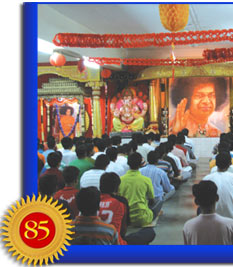 |
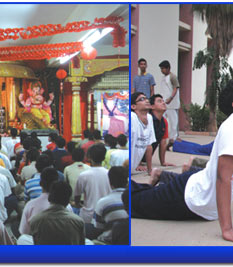 |
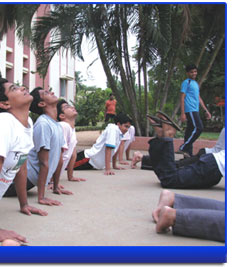 |
At the end of the morning exercises, the boys take their shower and settle down for a sound breakfast.
Once the boys assemble in the school, stilling of their minds is accorded first priority before the classes begin. This is achieved through the chanting of Vedic hymns in the school Prayer Hall. The whole school learns and recites the Vedas together. This activity too was personally initiated by Baba, when one morning in June 1983, Baba instructed Mr. Veda Narayan, who had just finished his Masters in Philosophy, to teach Vedam to the students at the school. For Mr. Veda Narayan, it was like a dream come true. He says: “Unlike elsewhere, where only a few are interested to learn the hymns, here the students were chanting Vedam en masse. I was thrilled. The students here were fortunate to receive ancient learning and modern knowledge: Baba had blended it so beautifully.”
Jeff, an American graduate from the Secondary School, says: “Baba has always encouraged me to chant these hymns and is very happy when I do it perfectly with the right intonations. Knowledge of the Vedas has given me a lot of confidence. I know I can do anything if I put my mind into it.”
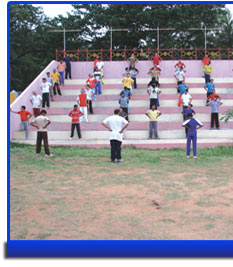 |
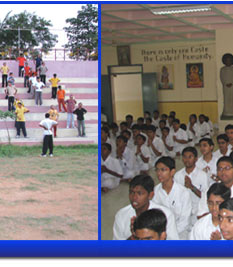 |
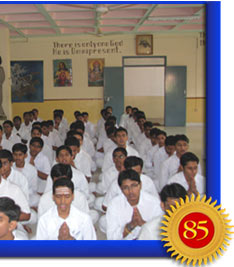 |
It is with such attitude and mental alertness that the boys finally enter their classrooms where they are taught the secular academic subjects, with generous doses of spirituality added whenever appropriate. Once the classes conclude in the afternoon, they rush back to the hostel for a quick wash, and in orderly lines proceed to the Mandir. Here begins their lessons for life, taught by the Divine Master, Baba, in His own mysterious way - sometimes vocally, at other times silently; sometimes directly and at other times subtly.
Life Lessons from Swami
 |
Mr. Habbu narrates a particular experience that took place during his tenure as the Principal of Sri Sathya Sai Higher Secondary School. He says: “It was one of the best days in the nine years of my service. The year was 1991.
“For the first time, the school had achieved 100% first class – every student of the twelfth grade had not only passed, but also secured first division. There was joy dancing on my face as Baba opened the door, and I immediately presented the scorecard to Him.
“This was the culmination of years of hard work. In fact, Baba had asked us to achieve this much earlier. But we missed it marginally. In 1986, we had 100% pass with 89 out of 96 students securing first class. I thought the school had done really well. Swami would be pleased. But His concern was about the four students who got second class and the three others who secured third class. He questioned us about it. The next year, much before the final exams, He said, ‘Identify the students who are weak in academics and hold extra classes for them. Nobody should be left out.”
For Baba, a few students securing 98% or 99% is not a cause for celebration, His concern is for the last boy. That is how He has built this institution.
Swami would make many visits to the school to enthuse and inspire the students. Once, during a science exhibition organised by the boys, Swami was fascinated with the models and interacted leisurely with each student. At the same time, He drove into them precious lessons.
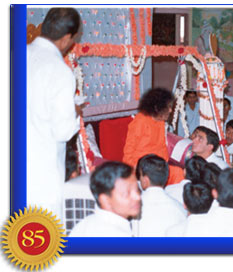 |
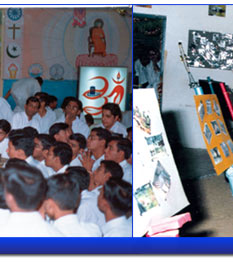 |
 |
One of the exhibition models was named ‘Burglar’s alarm’. The moment one put his hand in front of that instrument, the alarm would go off. The boys requested Baba to place His hand in their enthusiasm to demonstrate the model. This He kindly did, but to the surprise of the boys the alarm failed to go off. In a state of panic, the boys tested the instrument and found it to be working fine. They asked Him to test it again, and He obliged for the second time. Once again, the alarm failed to oblige! The boys were confused and crestfallen. Then, with a mischievous smile, Baba said, “I am not this kind of a thief. I am Chittachora, a stealer of hearts.”
Intellectual and Emotional Development
 |
Commenting on the scholastic performance of the students, Dr. Shailesh Srivastava, the Physics teacher, says: “One should keep in mind that the boys in this school achieve such excellent academic results with only two hours of study time every night. This is true even for those in the tenth and twelfth grades. I once heard an external examiner say, ‘I wonder how these boys produce such good results with only two hours of study everyday. Maybe, in those two hours, they really study and absorb a lot.”
Shivam, a twelfth grader, responds to this observation beautifully. He says: “We do more of intensive study than extensive study. Our schedule is planned in such a way that we have time for everything. It is something like a switch going off and on. When we are on the ground, we play vigorously, but when it comes to study hours, we concentrate completely. If we do not do that, we know we will not find that much time again. In the beginning, due to mental inertia, we may not be able to shift our focus from one activity to another instantaneously, but with time, the system just gets into you. Your concentration levels automatically go up.”
Drawing comparisons with schools worldwide that provide education solely for developing the mind, Mr. Misra, the English teacher, points out, “Man is not just a body of intellect, he has emotions and feelings, and more important, awareness, which is based on the soul.
 |
“Baba’s school endeavours to develop the entire personality of an individual, which is the most beautiful aspect – while there is development of the body and the mind, there is also enrichment of the heart and the soul, of emotions and compassion. Therefore, what you see as a product is an integrated personality that humanity needs now more than ever.
“One day, I was sitting in the Mandir verandah cross-legged on the ground, and writing something. I didn’t have a writing pad or board; therefore, the paper was on my knee. Even though it was difficult, I continued to write with my head down. A student who was sitting a few yards away from me noticed this, quietly came over, placed a board on my knee, and walked back quietly. When I looked up, he was already seated; so I really didn’t know who it was. Nobody had told him; I hadn’t asked for it.
“What’s most remarkable about the gesture was that the student didn’t even want to be recognised for it. It is this sense of awareness, to feel for the other and respond spontaneously and whole-heatedly, is what makes the students of the school extraordinarily special. And this, I believe, is truly Baba’s making. His Love does wonders, and every brick and stone, pupil and teacher in this school can vouch for it.”
 |
Mr. Sai Surendranath, the teacher who coordinates the talent search programme in the school, talks about some of his precious discoveries. He says, “Over the years I have seen boys who used to fumble while speaking steadily blossom into excellent orators. Those who used to fiddle around with the tabla have gone on to become excellent percussionists confidently performing in front of Bhagavan. Others who were scared to stand and talk now play leading roles in the Convocation drama of the University, and so on.
“I remember there was a student in the eleventh grade who used to sing only when he was alone in his room. He had a lovely voice, but would never sing if anybody was around. I encouraged him to come out of his shell several times, but I had no impact on him.
“Once we learned Baba was to visit the hostel the next day. I called this boy, gave him a cassette and said, ‘There is a beautiful song in this tape that will suit your voice. Please learn this song. If you practice, you could sing this when Baba is sitting on the swing in the hostel quadrangle. It is a great opportunity. If you feel you are not confident, we can cancel even in the last moment. So, there is no need to worry. Just give it a try.’ Baba came and enjoyed the boy’s performance so much that He asked him to start singing bhajans in the Mandir next day. Today he is a professional vocalist.”
Love and Respect – A Way of Life in Sai School
 |
Narrating his personal experience, Mohammad Falzuddin, a twelfth grade Muslim student from Karnataka, says: “All my roommates are so kind and co-operative. Whenever I sit down to perform Namaaz during the day, the room suddenly becomes silent. And all the teachers too encourage me to offer daily prayers and observe fasting during the holy month of Ramzan.
“During one particular Ramzan month, I was very particular about keeping my Roza or fast for which one is required to partake food before sunrise. So, on the first day of Ramzan, I preserved a little from the previous night’s dinner in my cupboard for the next morning breakfast.
“When my hostel teacher came to know of this, from the next day onwards he arranged fresh breakfast for me before 5.00 a.m. I feel blessed to be studying in such an environment.”
“In fact, when one of the teachers became aware of the trying times our family was going through at that time because of which I was unable to pay the minimum hostel fees, he told me not to worry. My dues were paid. Staying in this hostel is truly a dream come true for me.”
 |
Mr. Janardhan, Warden of Sri Sathya Sai Junior Boys Hostel, says: “Our only objective is to inculcate love in the hearts of boys. Ours is a small world where each lives for the other and all live for God. This is our motto. We take care of every single need of the boys inside the hostel premises itself. They do not have to go outside for anything. In fact, the hostel is actually run by the boys, we only guide them.”
Mr. Venkateswarlu, the Mathematics teacher, narrates an interesting experience: “A few years ago, one of our students was travelling in a bus from Chennai to Puttaparthi. On the way, the bus met with a minor accident. Nobody was hurt but the headlights of the vehicle would not work. And it was in the middle of the night. The bus driver, understandably, refused to drive further. The passengers requested him to move slowly, but he would not relent. Then, our student requested the driver for the toolkit. Within a few minutes, he succeeded in fixing the headlights much to the delight of all the other passengers. The driver, instead, was taken aback. He said to the boy, ‘Do you work in some kind of a mechanic shop?’ The boy said, ‘No. I am student in Swami’s hostel. We are taught many skills. I work in the maintenance department of the hostel.”
End of Education is Character
Taking a macro view on the purpose of the school and its relevance to contemporary living, Mr. Shivramakrishnaiah, the current Principal of Sri Sathya Sai Higher Secondary School, says: “The goal of our existence is intertwined with Bhagawan’s grand education mission. There is no difference. In fact, the school is a part of His divine master plan to present mankind with an alternate and most effective system of learning, which alone can rescue modern education from its present crisis and raise it to a level where it can create enlightened individuals who have the capability and competency to guide humanity to a new and noble destiny.”
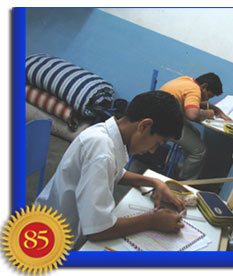 |
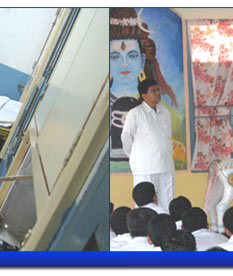 |
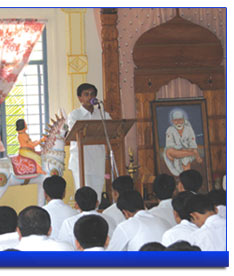 |
Perhaps the thoughts shared by Mr. T.M. Gopikrishna, an alumnus, perfectly encapsulate the essence of the Sai schools. He says: “Very clearly, we, as Swami’s students, have advantage over others because of one factor – self-confidence, the basis of which is absolute faith. We know that Swami is always there with us to guide us through. This allows us to take risks both professionally and personally on matters we strongly believe in. In terms of outlook and personality, it has made me more empathetic to others. I realise I need to look at personal equations from the other person's perspective, and this is exactly what Swami does too. Truly, whatever I am today is because of my stay with Swami at His school.”
This sacred seat of learning remains untainted as it involves no monetary transaction or exchange. For four decades, all Sai Education from kindergarten to the doctorate level is offered free of cost. Unthinkable as it sounds, thousands of students have graduated from the portals of the school contributing only a nominal sum for their hostel accommodation and food. No tuition fee has ever been charged.
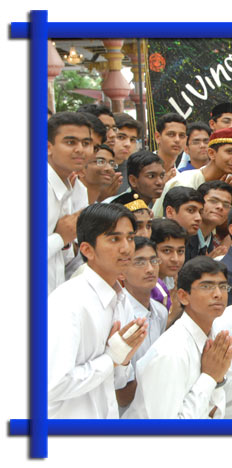 |
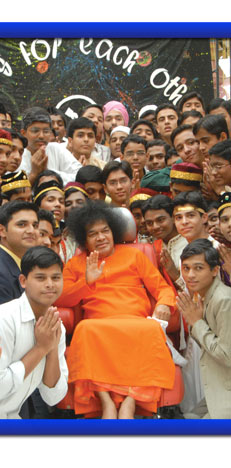 |
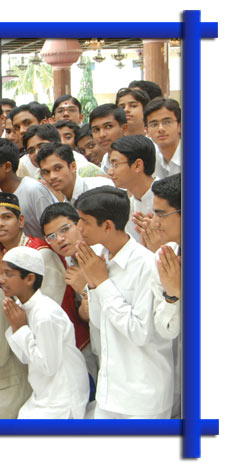 |
Increasingly, students, parents, educators, policy makers and government bodies around the world see the Sri Sathya Sai Higher Secondary School as the ideal model of education to emulate for preparing wholesome students who can face the challenges of our times with a deeper sense of social and spiritual responsibility.
By redefining the true aim of education to be the blossoming of the inner self and the development of human character, Baba has rewritten the destiny of the human race. Today, not only in contemporary India, but also around the world, the Sri Sathya Sai Educare is being recognised as the panacea for the ills of modern society.
(To be continued)
- Heart2Heart Team
What are your impressions about this article? Please share your feedback by writing to h2h@radiosai.org. Do not forget to mention your name and country.






